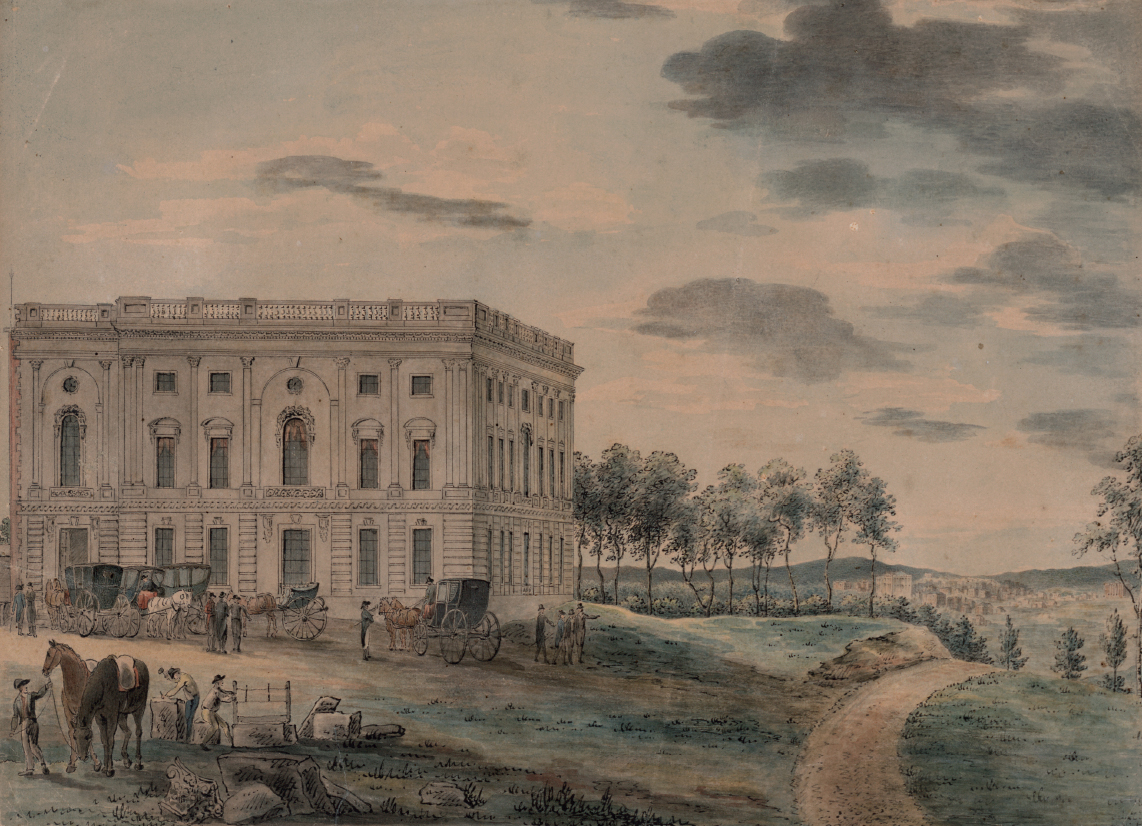Exploring American Histories: Printed Page 233
Exploring American Histories, Value Edition: Printed Page 197
Building a National Capital

The construction of Washington City, the nation’s new capital, depended on the labor of slaves as well. The capital was situated along the Potomac River in an area surrounded by farms and plantations. More than 300,000 slaves lived in Virginia and Maryland, the states that provided the land for the federal district, and the commissioners appointed to oversee the city’s construction held almost 100 slaves themselves. Between 1792 and 1809, dozens of enslaved men were hired out by their owners, who were paid $50 to $70 annually for their slaves’ labor on the city. Most enslaved men cleared land, built roads, and constructed the White House and the Capitol. Some performed skilled labor as carpenters and sawyers (who cut trees and lumber) or as assistants to stonemasons and surveyors. A few enslaved women were hired as cooks, nurses, and washerwomen.
Free blacks also participated in the development of Washington, working in many of the same positions as slaves did. One of the most noteworthy African Americans involved in the project was Benjamin Banneker, a self-taught clock maker, astronomer, and surveyor. He was hired as an assistant to the surveyor, Major Andrew Ellicott, in 1791, helping to plot the 100-square-mile area on which the capital was to be built.
African Americans worked alongside whites, including many Irish immigrants, whose wages were kept in check by the availability of slave labor. Most workers, regardless of race, faced poor housing, sparse meals, and limited medical care as well as malarial fevers. Despite these obstacles, in less than a decade, a system of roads was laid out and cleared, the Executive Mansion was built, and the north wing of the Capitol was completed.
Although Washington City was considered a symbol of the nation, it was experts from abroad who created the U.S. capital. The streets were laid out according to plans developed by the French engineer Pierre L’Enfant, the Executive Mansion was designed by the Irish-born James Hoban, and the Capitol building was envisioned by the West Indian physician turned architect (and colonizationist) William Thornton. The Capitol’s construction was directed by the English architect Benjamin Latrobe, and African Americans and immigrants made up the majority of the labor force. What was perhaps most “American” about the nation’s capital were the diverse races and nationalities that designed and built it.
Washington’s founders envisioned the city as a beacon to the world, proclaiming the advantages of republican principles. But its location on a slow-moving river and its clay soil left the area hot, humid, and dusty in the summer and muddy and damp in the winter and spring. When John Adams and his administration moved to Washington in June 1800, they considered themselves on the frontiers of civilization. The mile-long road from the Capitol to the Executive Mansion was filled with tree stumps and was nearly impossible to navigate in a carriage. On rainy days, when roads proved impassable, officials walked or rode horses to work. That November, when Abigail Adams moved into the Executive Mansion, she complained that the roof leaked, the huge house was hard to heat, and firewood was difficult to obtain. Abigail Adams was not alone in criticizing the capital city. Although the founders considered it “an experiment in republican simplicity,” most residents painted Washington in harsh tones. New Hampshire representative Ebenezer Matroon wrote a friend, “If I wished to punish a culprit, I would send him to do penance in this place . . . this swamp—this lonesome dreary swamp, secluded from every delightful or pleasing thing.” Others described the city as a “fever-stricken morass.”
Despite the drawbacks, the new capital played an important role in the social and political world of American elites, drawing wealthy and influential Americans to this center of federal power. From January through March, the height of the social season, the wives of congressmen, judges, and other officials created a lively schedule of teas, parties, and balls in the new capital city. When Thomas Jefferson became president, he opened the White House to visitors on a regular basis, a style that seemed appropriate for the man who had drafted the Declaration of Independence. This, too, helped reshape the Washington social scene. Yet for all his republican principles, Jefferson moved into the Executive Mansion with a retinue of slaves.
In decades to come, Washington City would become Washington, D.C., a city with broad boulevards decorated with beautiful monuments to the American political experiment. And the Executive Mansion would become the White House, a proud symbol of republican government. Still, Washington was characterized by wide disparities in wealth, status, and power, which were especially visible when Jefferson occupied the Executive Mansion and slaves labored in its kitchen, laundry, and yard. Moreover, President Jefferson’s efforts to incorporate new territories into the United States only exacerbated these divisions by providing more economic opportunities for planters, investors, and white farmers while ensuring the expansion of slavery and the decimation of American Indians.

Review & Relate
|
How did developments in education, literature, and the arts contribute to the emergence of a distinctly American identity? |
What place did blacks and American Indians inhabit in the predominant white view of American society and culture? |